Class 6 Science Chapter 4 Extra Questions and Answers Exploring Magnets
NCERT Class 6 Science Chapter 4 Exploring Magnets Important Extra Questions and Answers
Magnetic and Non-magnetic, Materials Class 6 Extra Questions
Question 1.
What are magnetic materials (substances)?
Answer:
Materials which get attracted by the magnet are called magnetic materials (substances).
Question 2.
What are non magnetic substances?
Answer:
Substances which are not attracted by magnet are called non¬magnetic substances.
Question 3.
Write the names of some non magnetic substances.
Answer:
Rubber, Cotton, Plastic, Wood, Button, Cloth, etc.
Question 4.
Name the first magnet.
Answer:
Lodestone.
![]()
Question 5.
What is lodestone?
Answer:
Lodestone is a type of iron. It bears the properties of magnet.
Question 6.
Make a list of given substances into two groups magnetic and non magnetic.
Key, Wood, Glass, Alpin, Chalk, Pencil, Nail, Cup of tea, Book, Rubber, Needle, Fork.
Answer:
Magnetic substances:
Key, alpin, nail, needle, fork (because all these stick to the magnet)
Non-magnetic substances
Wood, glass, chalk, pencil, cup of tea, book, rubber, (none of these sticks to the magnet)
Question 7.
What are the properties of a magnet?
Answer:
- It attracts iron pieces towards itself.
- It always aligns itself in the same direction, if left to rotate freely.
- It is composed of oxides of iron (Fe 3 O 4 ).
Question 8.
What are soft and hard magnetic materials?
Answer:
Soft iron is called soft magnetic material because it loses its magnetism easily. Soft iron is used in making electromagnets. Steel is called a ‘hard’ magnetic material because it does not lose its magnetism so easily. It is used to make permanent magnets.
Question 9.
How will you test that ‘tea dust3 is not adulterated with iron powder?
Answer:
We will test that ‘tea dust’ is not adulterated with iron powder by using magnet. If it has iron powder they will stick onto the magnet.
Question 10.
Four identical iron bars were dipped in a heap of iron filings one by one. Fig. shows the amount of iron filings sticking to each of them.
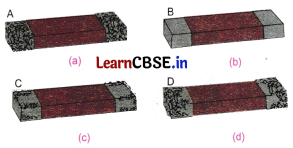
(a) Which of the iron bar is likely to be the strongest magnet?
(b) Which of the iron bars is not a magnet? Justify your answer.
Answer:
(a) A
(b) B because there are no iron filings sticking to it.
Question 11.
Suggest an arrangement to store a U shaped magnet. How is this different from storing a pair of bar magnets?
Answer:
U shaped magnet: One metal plate is placed across the two poles of the U shaped magnet.
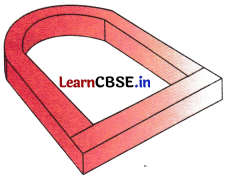
Bar magnet : Use two metal plates and one wooden block, arrange them as shown in the figure.
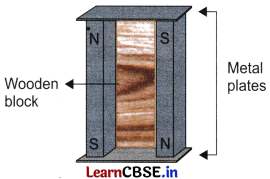
Poles of Magnet Class 6 Extra Questions
Question 1.
Fill in the blanks:
1. When a suspended magnet comes to rest, one pole always points towards the ______
2. And the other pole always points towards the ______
Answer:
- North
- South
Question 2.
How many poles are there in a magnet?
Answer:
There are two poles in a magnet, north-pole and south-pole.
Question 3.
To which part of the magnet do the most of the iron filings (or pins) stick?
Answer:
Most of the iron filings (or pins) stick to the poles, i.e., north and south poles. At these poles of magnet, magnetic effect is maximum.
Question 4.
To which part of the magnet do none or only a few iron filings (or pins) stick?
Answer:
Minimum number of iron filings stick to the middle part of the magnet. Magnet has its magnetic effect least in this part (middle part).
Question 5.
Are both poles of a magnet similar?
Answer:
No, the two poles of a magnet are not similar (alike). Both have different tendency. The pole that points towards the north is called north-pole while the pole pointing always towards the south is called south-pole.
![]()
Question 6.
Which is the north-pole of a bar magnet?
Answer:
It is the tip of a bar magnet which points towards the north direction.
Question 7.
Which is the south-pole of a bar magnet?
Answer:
It is the tip of a bar magnet that points towards the south direction.
Question 8.
Why does a freely suspended magnet always rest in north-south direction ?
Answer: A freely suspended magnet always rest in north-south direction because the north-pole of the magnet lies in the geographic north direction and the south pole of the magnet lies in the geographic south direction. So it aligns itself in N-S direction.
Question 9.
Can we isolate north-pole or south-pole?
Answer:
No, we cannot isolate north- pole of a magnet from its south-pole or vice versa. If you break a bar magnet into two halves, you will not get a single north or south pole but two magnets each with its north and south-poles.
Question 10.
What happens when a pole of a bar magnet say its north-pole is marked with a chalk and suspended freely? What do you observe on rotating the bar magnet?
Answer:
The marked pole comes to rest in north direction. On rotating, after some time, it again comes to rest in north direction.
Question 11.
Do magnetic poles exist separately like charges? Explain.
Answer:
Magnetic poles do not exist separately like positive and negative charges. This means that it is not possible to isolate a north pole of a magnet from its south pole by cutting the magnet from the middle. Whenever a bar magnet is cut into two halves, we get two new magnets, each with its north and south poles. This will continue indefinitely even if extremely small pieces of bar magnets are obtained. Thus magnetic poles always exist in pairs.
Question 12.
Where are the poles of a ring magnet? How will you find this?
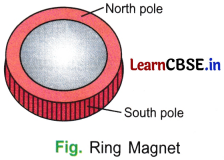
Answer:
Ring type or circular magnet also has two poles. Its exterior and interior parts act like different poles.
To find out the nature of the two poles, we suspend circular magnet with a piece of thread. We bring another magnet near it. Both attract each other. It clearly concludes that one surface of the circular magnet is attracted but the other surface is repelled by the same pole of the other magnet.
Question 13.
Mark the north-poles of two bar magnets and bring the poles of the magnets near each other, and note down your observations in table.
Answer:
| Poles, facing one another | They are called | We observe |
| North – South | Opposite poles | Attraction |
| North – North | Similar poles | Repulsion |
| South – South | Similar poles | Repulsion |
| South – North | Opposite poles | Attraction |
Question 14.
What will happen to the magnet when we cut it into two pieces?
Answer:
When we cut a bar magnet into two pieces, both these pieces act as magnets and we get two magnets (Fig.).
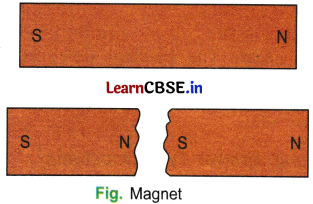
Question 15
1. A toy car has a bar magnet laid hidden inside its body along its length. Using another magnet how will you find out which pole of the magnet is facing the front of the car?
2. You are provided with two identical metal bars. One out of the two is a magnet. Suggest two ways to identify the magnet.
Answer:
- If the front of the toy car gets attracted to the north pole of the given magnet then it is the south pole of the bar magnet hidden inside the car. On the other hand, if it repels, then it has a north pole in front.
-
Two ways to identify the magnet are:
- By suspending the metal bars
- By attracting iron filings.
Finding Directions Class 6 Extra Questions
Question 1.
In which direction does freely suspended magnet rest?
Answer:
A freely suspended magnet always points in the north-south direction.
Question 2.
How do the shipmen find the direction even when north pointing pole star is not visible?
Answer:
Shipmen during navigation can find the “direction with the help of magnetic needle.
Question 3.
Why is compass needle kept in a closed glass vessel?
Answer:
Compass needle is a small and thin magnet used to find the direction. If it is kept in open, it may deflect in any direction due to pressure exerted by air. So to know right direction, it is kept covered by glass covering.
Question 4.
Does the compass needle point in different directions?
Answer:
The compass needle has a magnetic needle closed in a glass covering. The needle can rotate on its pin pointed base. Its red marked end always indicates towards the north direction. It always rests in north-south directions. We use it to find out the direction.
![]()
Question 5.
Hang a bar magnet with a thread on a stand and rotate the base of stand. What will happen?
Answer:
The direction of bar magnet is not changed as we rotate the stand. It is because a freely suspended magnet comes to rest in particular direction, i.e., north-south directions.
Question 6.
Fig. shows a magnetic compass. What will happen to the position of its needle if you bring a bar magnet near it? Draw a diagram to show the effect on the needle on bringing the bar magnet near it. Also draw the diagram to show the effect when the other end of the bar magnet is brought near it.
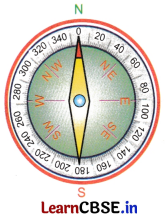
Answer:
The magnetic needle of the compass will get deflected.
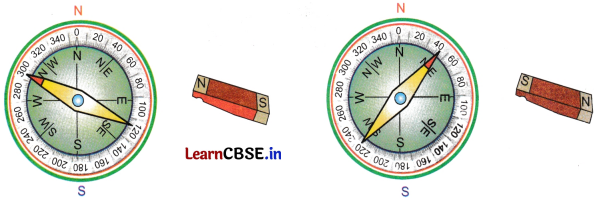
Attraction and repulsion between magnets Class 6 Extra Questions
Question 1.
What happens when similar poles come close to each other?
Answer:
They repel each other.
Question 2.
When do two magnets attract each other?
Answer:
Two magnets attract each other when their unlike (opposite) poles come close to each other.
Question 3.
What do you mean by magnetic field?
Answer:
The region around the magnet where its magnetic influence can be felt is called the magnetic field of the magnet.
Question 4.
Three identical iron bars are kept on a table. Two out of three bars are magnets. In one of the magnet the North-South poles are marked. How will you find out which of the other two bars is a magnet? Identify the poles of this magnet.
Answer:
The magnet with known poles will attract and repeat two ends of a magnet and attend both the ends of an ordinary bar. (Test for repulsion).
Question 5.
Boojho kept a magnet close to an ordinary iron bar. He observed that the Iron bar attracts a pin as shown in Fig.

What inference could he draw from this observation? Explain.
Answer:
The inference he could draw from this observation that the magnetic properties are induced into the iron bar and it acts like a magnet.
Question 6.
A bar magnet is cut into two pieces A and B, from the middle, as shown in Fig.

Will the two pieces act as individual magnets? Mark the poles of these two pieces. Suggest an actimty to verify your answer.
Answer:
Yes, by the test of repulsion.

Question 7.
How can you show that unlike poles attract each other while like poles repel each other?
Answer:
Suspend a magnet on a stand with the help of a string. Now it rests in N-S directions. Take another magnet which has been marked NTS on it and bring N-pole of this magnet near the N-pole of the suspended magnet. You will find that the suspended magnet rotates and moves away showing that like poles repel each other. The same can be repeated by bringing south-pole of one magnet near south-pole of suspended magnet.
Now you must have found that during the above experiment, south-pole comes towards north-pole and vice versa. It can be repeated by bringing south-pole near a north-pole and north-pole near south-pole of suspended magnet. You will find that unlike poles attract each other.
Question 8.
Bhawana witnessed an interesting game at the fair. A duck was floating in a tub. When a plate containing some grains of rice was brought close to the duck, the duck moved towards the plate. But, when a plate containing some pebbles was brought close to; the duck, it moved away from the plate. Explain how this could have been possible.
Answer:
This game is based on the plate containing rice which may have magnet attached to its bottom. The magnet is fitted in such a way that its north-pole points towards rice grains, while south- pole indicates towards pebbles. A magnet (bar magnet) may also be fitted in the bottom of the duck, where south-pole points towards mouth and north-pole towards tail of the duck.
When the rice portion of the plate is brought closer to the duck, the duck moves towards rice grains because unlike poles of two magnets attract each other. In second situation, same (like) poles repel each other. So the duck moves away.

Fun with Magnets Class 6 Extra Questions
Question 1.
Why should we not beat or hammer a magnet?
Answer:
By heating or hammering a magnet may loose its magnetic property. It is thus advised not to bear or hammer a magnet.
Question 2.
Why magnets should be kept away from mobiles, computer and compact disks (CDs)?
Answer:
Televisions, mobiles, CD, computers and many more devices are made up of magnetic materials and magnets in it. If you bring a magnet closer to it then it will spoil these devices.
Question 3. Mention some important precautions to handle magnets.
Answer:
- Do not heat
- Do not hammer
- Do not drop
Question 4.
It was observed that a pencil sharpener gets attracted by the poles of a magnet, although its body is made of plastic. Name a material that might have been used to make some part of it.
Answer:
The blade of a pencil sharpener is made of iron which is a magnetic , material. Due to this a pencil sharpener gets attracted towards the poles of a magnet.
![]()
Question 5.
What is the correct way of storing a bar magnet? Also support your answer with diagram.
Answer:
Bar magnet: Two-bar magnets should be placed inside a wooden box so that:
(a) the poles of two magnets lie opposite to each other.
(b) a wooden piece should be kept between the two magnets.

Question 6.
What are the precautions need to be taken while handling a magnet
Answer:
When heated, hammered or dropped from a height, magnets tend to lose their properties. They become weak if they are not stored properly and hence:
- Bar magnets should be stored in pairs separated by a small block of wood and their unlike poles facing the same side with a soft iron across their ends.
- A piece of iron should be kept across the poles in case of a horse shoe magnet.
- Magnets should be kept away from computers, mobiles, televisions etc.
- Magnets should be handled with care and they should be stored properly.